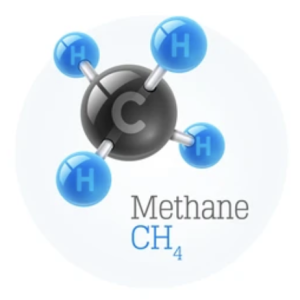Methane, not just hot air.
Where does methane come from? Methane reduction
Methane is a natural gas that’s produced by microbes through a process of anaerobic (no-oxygen) fermentation.
All plant material is composed of three elements – Carbon, Hydrogen and Oxygen, linked together in numerous ways, to build either simple or complex sugar molecules.

When livestock graze on pastures, crops or intensive grain-based diets, the microbes in the rumen start the process of ‘microbial fermentation’. These microbes break up the Carbon, Hydrogen and Oxygen molecules and reassembles them into other compounds such as short chain volatile fatty acids (VFA) and methane (CH4). There are varying species of microbes that build these compounds. Microbes that specifically use Carbon and Hydrogen to produce methane are called ‘methanogens’.
DID YOU KNOW: Methane is mostly released through the mouth, not the back end of the animal.
What’s the impact of methane on our environment?
Methane is a highly effective compound to trap heat. “Free” methane accumulates in the atmosphere & acts like a blanket, resulting in global warming. This warming may decrease potential crop yields by 15% and increase the rate of respiratory and cardiac disease in humans.
Methane has a short life span.
While the impact of methane is extremely negative, it has a relatively short life span in the atmosphere, about 12 years. This means that if we act now, we can create meaningful change in our industry within a relatively short time. Leaving the environment in better shape for the generations to come.
How do ProAgni products reduce methane?
Gut efficiency in livestock, a key to methane reduction?
The first part of a ruminant’s digestive tract is home to a massive population of microbes. These microbes are responsible for the primary breakdown of plant material. The activity and efficiency of this process directly relates to the composition of their feed. This breakdown process is responsible for up to 80% of total energy and protein requirements. Less-digestible, higher fibre and lower starch-based diets result in lower efficiency and alkalosis where more methane is produced.
The bottom-line impact
The loss of methane into the atmosphere represents a loss of energy that could have been used in livestock production. Producers pay a price for that loss of efficiency. These losses are between 4%-15% of total feed energy, depending on feed type and efficiency of fermentation. Reducing methane can help to capture and divert that energy into increased production without increasing feed costs.
Through management and supplementation, you can directly impact your methane output today.
ProAgni ProTect® supplements work in two key ways: improving overall diet composition and improving efficiency by specifically targeting the activity of methanogens.
- High quality, energy-dense supplements, such as cereal grains, help improve the overall efficiency of the rumen and deliver high concentration feeds which decrease overall dry matter consumption (on a daily basis) and therefore decrease methane output. However, these cereal grains can cause ruminal pH to dip into a more acid state making acidosis a real risk. A high-quality premix like ProTect® C or S will help manage ruminal pH within safe parameters. These supplements contain ingredients than change the activity and fermentation process of the rumen potentially increasing efficiency.
- Some essential oils, yeast extracts and plant lipids have also shown positive impacts on methane production. ProAgni loose licks (ProDry, ProMark, ProGreen and ProGreen HiThi) and our ProTect® product range all contain these mitigating substances.
Check out our University of New England trial data or watch the video of our trial results below. For pricing and availability please contact your nearest reseller.
